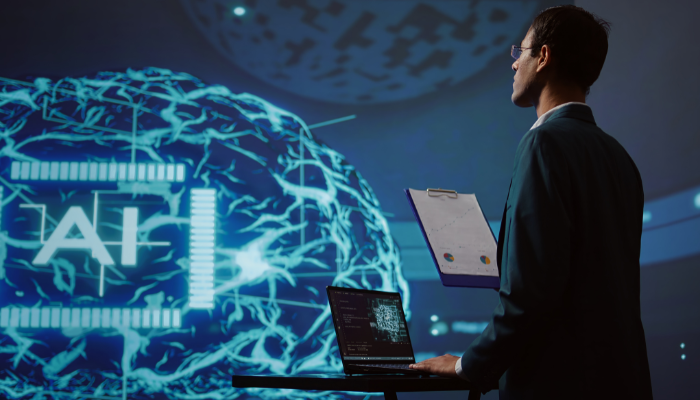“The future is already here — it’s just not evenly distributed.” – William Gibson
Today’s industries, especially those that rely on real-time data, are feeling the heat. That’s where edge AI development steps in. Instead of sending data to the cloud and waiting for answers, edge AI processes data right on the spot.
It’s like having AI brains right on your devices—making fast decisions in real-time. This is a game-changer for industries like healthcare, self-driving cars, and manufacturing, where every millisecond counts.
In fact, Gartner says that by 2027, over 75% of enterprise-generated data will be processed without traditional data centers. That’s a big deal! Businesses are realizing they can’t afford to wait for slow data to come back from the cloud. They need answers right now, especially when every second counts.
But what does this really mean for you? How does edge AI actually work, and what industries stand to gain the most? In this blog, we’ll explore how edge AI is reshaping everything from data privacy to real-time insights.
Let’s jump in!
Edge AI: Bringing AI to the Edge
Edge AI is when AI processes data directly where it’s created, like on a device or sensor. Instead of sending information to a cloud server far away, edge AI makes decisions instantly, on the spot. This helps things run faster and smoother.
How Edge AI Works?
Edge AI systems typically consist of a combination of hardware and software components. The hardware may include microcontrollers, System on a Chip (SoC) devices, or specialized AI accelerators. The software component consists of AI algorithms and models that are optimized for running on these hardware platforms.
When data is generated, it is processed by the Edge AI system. The system applies the AI algorithms to extract meaningful insights from the data and make decisions or take actions based on the results. This process happens locally, without the need to transmit data to a remote server.
Why Does It Matter?
When every second counts, relying on distant cloud servers isn’t practical. Imagine self-driving cars—if they waited for cloud data, accidents would happen! Edge AI steps in by processing data locally, making decisions in real-time.
Now, let’s look at how Edge AI is being utilized in real-world applications, showcasing its impact across various industries.
Edge AI in Action: Real-World Applications
Edge AI is revolutionizing industries across the globe, empowering devices to make intelligent decisions at the edge of the network. Let’s explore some compelling examples of Edge AI in action:
Manufacturing and Industrial Automation
- Predictive Maintenance: Edge AI can analyze sensor data from machines to predict failures before they occur, reducing downtime and maintenance costs.
- Quality Control: AI-powered cameras can inspect products in real-time, identifying defects and ensuring quality standards are met.
- Autonomous Robots: Robots equipped with Edge AI can navigate complex environments, collaborate with human workers, and perform tasks with greater autonomy.
Healthcare
- Remote Patient Monitoring: Wearable devices and medical sensors can transmit patient data to Edge AI platforms for real-time analysis, enabling early detection of health issues.
- Medical Imaging: Edge AI can accelerate the analysis of medical images, such as X-rays and MRIs, aiding in diagnosis and treatment planning.
- Surgical Assistance: Robotic surgical systems powered by Edge AI can assist surgeons in performing complex procedures with greater precision and accuracy.
Retail and E-commerce
- Personalized Recommendations: Edge AI can analyze customer behavior and preferences to deliver tailored product recommendations, enhancing the shopping experience.
- Inventory Management: AI-powered cameras can track inventory levels in real-time, optimizing stock management and reducing the risk of stockouts.
- Smart Checkout: Edge AI can enable frictionless checkout experiences, such as self-checkout kiosks and automated payment systems.
Transportation and Logistics
- Autonomous Vehicles: Self-driving cars and trucks rely on Edge AI to process sensor data, make real-time decisions, and navigate safely.
- Traffic Management: Edge AI can analyze traffic patterns, optimize traffic flow, and reduce congestion.
- Smart Parking: AI-powered sensors can detect available parking spaces and guide drivers to empty spots, improving parking efficiency.
Smart Cities
- Urban Surveillance: Edge AI can analyze video footage from surveillance cameras to detect crime, identify suspicious activities, and improve public safety.
- Environmental Monitoring: AI-powered sensors can monitor air quality, noise levels, and other environmental factors, helping cities to make informed decisions.
- Smart Energy Grids: Edge AI can optimize energy consumption, manage renewable energy sources, and improve grid reliability.
These are just a few examples of how Edge AI is transforming industries and improving our daily lives. As technology continues to advance, we can expect to see even more innovative applications of Edge AI in the years to come.
Ready to learn about how Edge AI architecture powers these instant decisions? Let’s get into it!
Understanding Edge AI Architecture: The Heart of Instant Decisions
Edge AI architecture lets AI run directly on local devices instead of depending on a cloud. This means data gets processed and decisions are made right where the action is happening.
In simple terms, it’s like bringing the brain of the AI closer to the problem, so it can respond faster and more securely. This setup is super useful for things like self-driving cars, smart factories, and other systems that need to make quick decisions without waiting for the cloud to process the data.
Edge AI Architecture: The Building Blocks
Let’s break down the key parts of Edge AI in simple terms:
Cloud Platform: Think of the cloud as the brain behind everything. It’s where AI models get trained, managed, and updated. The cloud also keeps track of how well the system is doing and makes improvements over time.
Edge Devices: These are the local devices doing all the heavy lifting in real time. For example, in a factory, they can keep an eye on machines and prevent breakdowns before they happen by analyzing data on the spot.
Environment: Edge AI works in places filled with sensors or video feeds. These sensors send data to edge devices, which then process it to give you instant insights. Retailers, for example, can use this to track how customers move around a store and adjust product placement for better results.
Wondering how Edge AI development operates?
How Edge AI Development Works: A Step-by-Step Breakdown
Let’s break down how Edge AI development works in simple steps. Here’s how the process unfolds:
Step 1: Training the AI Models
This first step involves teaching the AI models using massive datasets. The cloud handles this training, helping the models learn to recognize patterns, similar to how detectives learn to spot different types of criminals.
Step 2: Deploying the Models
After training, the models are sent to the edge devices. This is like sending detectives out into the city to put their skills to work. The edge devices are now ready to process information right where it’s needed.
Step 3: Collecting Data
With the edge devices in place, they start collecting data from their surroundings. This includes input from sensors, cameras, and other sources. Gathering quality data is essential because it impacts the accuracy of the decisions made later.
Step 4: Processing Data
With the data collected, edge devices now analyze it using the trained AI models. This is where the real work happens, as the devices interpret the information to identify patterns or unusual activity.
Step 5: Making Decisions
Based on the processed data, edge devices take action. They can trigger alerts, control machinery, or provide insights—all in real time. This decision-making is crucial for effective responses.
Step 6: Feedback Loop
Finally, edge devices send feedback back to the cloud about how well they’re performing. This feedback loop is important because it helps improve the models over time, ensuring they adapt to new situations.
Now that you understand how it works, let’s talk about why Edge AI is such a big deal.
The Perks of Edge AI: Why It’s a Game-Changer
Edge AI is changing how businesses work by providing fast, secure, and real-time solutions. Instead of relying on the cloud for everything, Edge AI processes data right on local devices, making everything quicker and more efficient.
Let’s look at eight key benefits of Edge AI development and how it can transform your business.
1. Real-Time Insights
With Edge AI, data is processed instantly on local devices. This means no more waiting for information to travel to the cloud and back. For example, in self-driving cars, this quick data processing helps them react immediately to their surroundings, improving safety.
2. Reduced Bandwidth
Because most data is analyzed locally, there’s less need to send huge amounts of information over the internet. This saves on bandwidth, which is a big relief for businesses with heavy data loads—like video surveillance systems or smart devices—keeping everything running smoothly.
3. Increased Privacy
Edge AI keeps sensitive data secure by processing it on local devices. Since there’s less data sent to the cloud, the chances of leaks or breaches are lower. This is crucial in fields like healthcare, where protecting personal information is essential.
4. Improved Availability
One of the great things about Edge AI is that it doesn’t depend on constant internet access. Devices can keep working even when the connection drops. For instance, in remote areas or places with unreliable connectivity, edge devices continue to function without issues.
5. Lower Costs
Sending large amounts of data to the cloud can get pricey. Edge AI development cuts down on this cost by reducing the need for continuous cloud services. For businesses looking to save money while still getting great performance, this is a major advantage.
6. Reduced Latency
When data is processed where it’s created, responses are much quicker. In industries like manufacturing, this means machines can make real-time adjustments, which helps prevent delays and boosts productivity.
7. Better Security
With less data traveling over the internet, Edge AI provides better security. Sensitive information remains local, making it harder for hackers to intercept it. This added protection is especially valuable in finance and defense sectors.
8. Energy Efficiency
Local data processing uses less energy compared to constantly sending data to the cloud. This makes Edge AI an energy-efficient option, particularly for IoT devices that often need to conserve power. It’s a smart way to save both energy and money.
Now that you understand why Edge AI is so powerful, let’s talk about the technology behind it.
Fueling the Edge AI Revolution: Key Technologies
Edge AI is changing the way we work by bringing smart technology closer to where the action is. Several key advancements are making edge AI faster, safer, and more effective.
Let’s explore five important technologies that are driving this revolution.
Maturation of Neural Networks
Neural networks have truly matured! They now come equipped with advanced machine learning capabilities that can tackle a variety of tasks. This means your devices can learn directly from local data, making edge AI development easier and more effective for your business.
Advances in Compute Infrastructure
Thanks to powerful distributed systems and parallel GPUs, processing data has become faster than ever. These advancements allow edge devices to handle large amounts of information right on-site. Picture a security camera that analyzes footage in real-time—no more waiting for data to be sent to the cloud! This kind of speed is essential for effective edge AI development.
Adoption of IoT Devices
The rise of Internet of Things (IoT) devices means we’re generating an incredible amount of data every second. From smart thermostats to connected cars, these devices are all around us. With 5G technology boosting connectivity, they can share information almost instantly. This is a game-changer for edge AI development, enabling quick responses and smarter decision-making.
Looking to get the most out of your smart devices?
Codewave can help you leverage the power of IoT to transform your business. They offer a wide range of services to help you design, develop, and implement an IoT solution that meets your specific needs.
Enhanced Data Privacy and Security
As we collect more data, privacy concerns are becoming more prominent. Luckily, Edge AI helps by processing information locally, which lowers the risk of data breaches. Keeping sensitive data on-site means better protection for your business, especially in industries like healthcare and finance where security is super important.
Integration with Cloud Services
Edge AI shines when it teams up with cloud services. This hybrid approach allows businesses to analyze data in the cloud while making quick decisions at the edge. For example, retailers can leverage cloud insights to understand shopping trends and manage inventory efficiently in real-time using edge AI development.
Why Settle for One When You Can Have Both?
Integrating Edge AI with cloud services creates a powerful combo for your business. At Codewave, we offer infrastructure development services that help you maximize data insights and streamline operations, giving you the best of both worlds. Let’s build something amazing together!
Now that we understand the key technologies, let’s clarify how Edge AI differs from Cloud AI!
Edge AI vs. Cloud AI: The Difference
As technology advances, you may be curious about the difference between Edge AI development and Cloud AI.
In simple terms, Cloud AI relies on centralized servers for processing data, while Edge AI operates directly on local devices. This makes Edge AI faster and better at keeping your data private, making it a strong option for various applications.
Edge AI: Your smartphone or smart home device processes data right on the spot. This allows for real-time data analysis without delays from sending information back and forth to the cloud.
Cloud AI: Data travels to centralized servers for processing. While effective, this method can create delays that aren’t ideal for applications requiring instant results.
Here’s a quick overview of the differences between Edge AI and Cloud AI:
| Feature | Edge AI | Cloud AI |
| Data Processing | Local devices | Centralized servers |
| Latency | Low | Higher |
| Privacy | Enhanced | Depends on data transfer |
| Bandwidth Usage | Minimal | High |
| Compute Power | Limited | High |
By understanding these differences, you can better assess which option aligns with your needs.
With this clarity, let’s discuss the challenges you may face in Edge AI development!
Overcoming Challenges in Edge AI Development
As Edge AI development continues to grow, it brings some challenges that you’ll want to keep in mind. By understanding these hurdles, you can find ways to make the most of this exciting technology.
Hardware Limitations
Even though edge devices have improved a lot, they still don’t match the computing power of cloud systems. This can limit the complexity of tasks they can handle.
Solution: Look for specialized hardware that boosts processing power. You might also consider a hybrid approach that combines edge and cloud processing for tougher tasks.
Security Risks
With Edge AI, processing happens locally, which can expose your devices to threats like hacking or physical tampering. Protecting sensitive data is essential.
Solution: Use strong security measures like encryption, regular updates, and physical device protection to fend off threats. Additionally, ensure compliance with industry regulations such as GDPR or HIPAA, especially in sensitive sectors like healthcare and finance, where safeguarding personal data is critical.
Better Safe Than Sorry!
Codewave offers penetration testing to find and fix security weaknesses before they become a big problem. Sleep soundly knowing your data is protected: Top QA testing services | Codewave
Model Maintenance
Keeping AI models updated across many devices can be tricky and time-consuming. It requires syncing with cloud platforms constantly.
Solution: Automate updates with efficient deployment strategies that reduce downtime and ensure every device has the latest model.
Data Management
Local storage on edge devices can be limited. If you can’t store all the data you need, it makes analysis tough.
Solution: Focus on processing data that’s immediately necessary and use cloud storage for less critical info, helping your edge devices run smoothly.
Edge devices getting overloaded with data? Feeling like a hamster on a wheel?
Codewave can help you develop a data strategy to keep things organized. They’ll show you what data matters most and how to use it for better results. Stop spinning your wheels, start getting insights!
Interoperability Issues
Getting different devices and platforms to work together can lead to compatibility problems. Smooth communication between systems is key.
Solution: Use standardized protocols and APIs to make integration easier and more effective across devices.
Network Reliability
Edge AI needs stable network connections to work well. Any disruptions can impact data processing and analysis, especially for real-time applications.
Solution: Set up backup systems and use edge caching to keep things running even if the network goes down, ensuring your applications stay operational.
With these challenges in mind, let’s take a look at the bright future of Edge AI development!
The Bright Future of Edge AI Development
As we look ahead, the future of Edge AI development is filled with exciting possibilities. Emerging trends and advancements will shape how we use this technology in our daily lives and industries.
Let’s explore what’s on the horizon.
Emerging Trends with 5G Technology
The rollout of 5G is a game-changer for Edge AI development. With faster data speeds and improved connectivity, edge devices will process and analyze data in real-time like never before. This means quicker responses for applications like autonomous vehicles and smart cities.
Ready to Ride the 5G Wave?
With 5G transforming Edge AI, the potential is limitless! At Codewave, our embedded technology innovation services can help you harness this power, creating smarter and faster solutions that keep you ahead of the curve.
Enhanced Scalability
As Edge AI technologies continue to mature, they will become more scalable. This scalability means you can easily deploy Edge AI solutions across various sectors, from healthcare to manufacturing. Imagine having smart sensors in cities that optimize traffic flow or personalized shopping experiences that cater to your preferences in real-time.
Improvements in AI Models
Ongoing research is set to make Edge AI models more efficient and powerful. These advancements will allow models to learn and adapt quickly, making them more effective across different use cases. As a result, you’ll see better decision-making and predictions, whether in healthcare diagnostics or predictive maintenance in factories.
Ready to put some smarts in your edge?
Codewave‘s AI development team can help you build custom AI models that are powerful, efficient, and ready to tackle your toughest challenges. Visit us at AI Development & Generative Solutions In India | Codewave to learn more!
Integration with IoT
The integration of Edge AI with Internet of Things (IoT) devices will enhance data collection and analysis. By processing data closer to the source, you can reduce latency and improve overall performance. Picture a smart home where devices communicate seamlessly, creating a more efficient living environment.
Focus on Sustainability
As Edge AI development progresses, there will be a growing emphasis on sustainability. Using edge devices can minimize data transfer to the cloud, reducing energy consumption. This shift can lead to greener technologies that are more environmentally friendly.
Now that you understand the possibilities, let’s summarize what we’ve learned.
Conclusion
As we wrap up our look at Edge AI development, it’s exciting to see how this technology is set to grow and change the world. The global edge AI market is expected to reach around USD 143.06 billion by 2034, showing just how big this opportunity is.
Albert Einstein once said, “In the middle of difficulty lies opportunity.” This couldn’t be more true for Edge AI. The future is filled with possibilities for new applications and improved machine learning capabilities. Whether it’s making cities smarter or creating personalized healthcare solutions, Edge AI development can help you build systems that meet real needs.
As you look into this exciting field, remember that every challenge can lead to innovation. With the right support from companies like Codewave, you can tap into the power of AI and machine learning to make a real difference. Our services will help you streamline processes and create applications that leverage the latest in AI technology.
If you’re ready to turn your ideas into impactful solutions, now is the time to get started. Check out our AI and Machine Learning Development services at Codewave, and see how we can assist you in shaping the future with powerful, intelligent solutions!
Codewave is a UX first design thinking & digital transformation services company, designing & engineering innovative mobile apps, cloud, & edge solutions.







